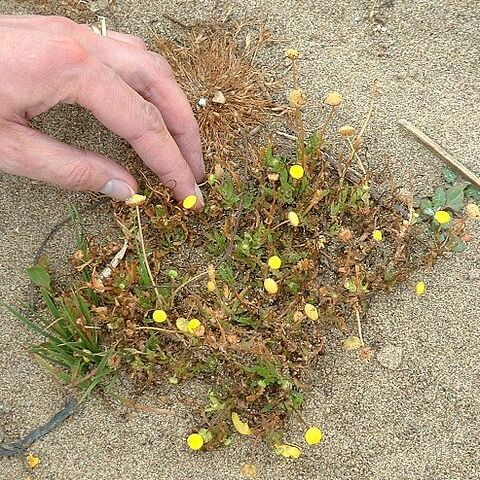Annual or perennial herbs. Leaves alternate, sometimes opposite or rosulate, pinnatisect, lobed, or sometimes entire. Capitula solitary, pedunculate, heterogamous, disciform, discoid, or rarely radiate with short rays; capitulum stalk sometimes inflated below the capitulum; involucre hemispherical, the phyllaries few-seriate, these slightly unequal, with scarious margins; receptacle flat to conical. Outer florets 1–multi-seriate, female, fertile, generally stalked, with short tube or no tube at all; disc florets hermaphrodite or some sterile intermixed, with (3–)4 lobes, sometimes saccate beneath, the lobes with resin canals, sometimes one lobe expanded to a radiate limb; anthers included, the bases obtuse; style ± included, the branches truncate or obtuse. Achenes dorsiventrally flattened, often laterally winged, usually with hairs; pappus absent.
Heads disciform, the outer 1–several series of fls pistillate, with short tubular cor, or rarely all the fls perfect; invol bracts slightly unequal, ca 2-seriate, membranous or subherbaceous, commonly with narrow scarious margins; receptacle naked, flat to conic; disk-fls usually fertile, with 4-toothed yellow cor; style-branches flattened, truncate, penicillate; achenes, especially of the outer fls, ± stipitate, compressed parallel to the invol bracts, commonly minutely striate, otherwise 2–4-nerved or nerveless; pappus a short crown or none; annual or occasionally perennial herbs with alternate, entire to more often pinnatifid or pinnately dissected lvs and small or medium-sized heads. 50, mainly S. Hemisphere.
Annual to perennial herbs, erect or sprawling. Leaves entire, lobed, or 1-or 2-pinnatisect, stem-sheathing (in Australia). Capitula solitary, disciform (in Australia) or discoid, with ligulate florets present in C. turbinata; involucre 2-or 3-seriate, with bracts all of similar length; receptacle epaleate. Florets often pedicellate. Outer florets 1–several-seriate, female; corolla usually lacking. Disc florets mostly bisexual, sometimes functionally male; corolla mostly 4-lobed. Achenes usually dimorphic, dorsally compressed, unribbed, hairy or not. Pappus absent.
Annual or perennial herbs, initially taprooted and often rooting at nodes. Lvs simple, entire to 1-2-pinnatisect, opposite or alternate. Capitula terminal, pedunculate; involucral bracts in (1)-2-3 rows, with membranous margins. Receptacle flat to hemispheric; scales 0. Outer florets ♀, in < 1 or 1-several rows; corolla much reduced or 0. Inner florets usually ☿, rarely ♂; corolla tubular or flattened, some outer florets rarely appearing ligulate. Achenes dimorphic: those of ♀ florets broadly winged; those of ☿ florets ribbed; pappus 0.

